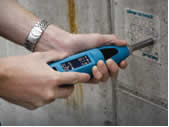Steps to Follow While Using a Schmidt Hammer
The Schmidt Hammer is
a valuable instrument for testing concrete. Inside the hammer is a sensor that
measures the rebound value of the test impact with repeatability and high
resolution. The hammer is also known as a ‘rebound hammer’, with ‘rebound’
pertaining to the effective, non-destructive way to measure the compressive
strength of concrete to within a 20 percent range, and the control of uniform
concrete quality in prefabricated structures and in-situ concrete. Certain
steps must be followed to ensure accuracy and proper use of the Schmidt Hammer.
Here are some of the guidelines to consider:
- Refer to ASTM C805-13 – The standard test method with a Schmidt hammer is listed under ASTM. The latest standard provides the procedures for the test method for rebound number of hardened concrete.
- Calibrate the hammer – A good supplier offers equipment with calibration certificates and recalibration services.
- Make sure the concrete is ready for testing – The surface of the concrete must be clean, dry, and smooth. Remove any loose particles or surface roughness by rubbing with a stone or grinding wheel. Avoid conducting a rebound hammer test on rough surfaces created by loss of grout, incomplete compaction, and rough finished or spalled concrete unless they are ground to a flat test area.
- Hold
it properly – Hold the Schmidt hammer at a right angle to the
surface of the concrete to be tested. That way, you can easily make a
reading and the test can be horizontally conducted on a vertical surface
and vertically downwards or upwards on a horizontal surface. Holding the
rebound hammer at an intermediate angle will yield a different
measurement, even if it is done on the same concrete mix. Make sure the
point of impact of the hammer on concrete is at least 20mm from a shape
discontinuity or the edge.
- Identifying
the reading – The Schmidt hammer should be used to takes at
least six readings at every point of testing, each at least 2cm separate
from each other and the average value is determined as the rebound index
for a corresponding observation area on the surface of the concrete.

Comments
Post a Comment